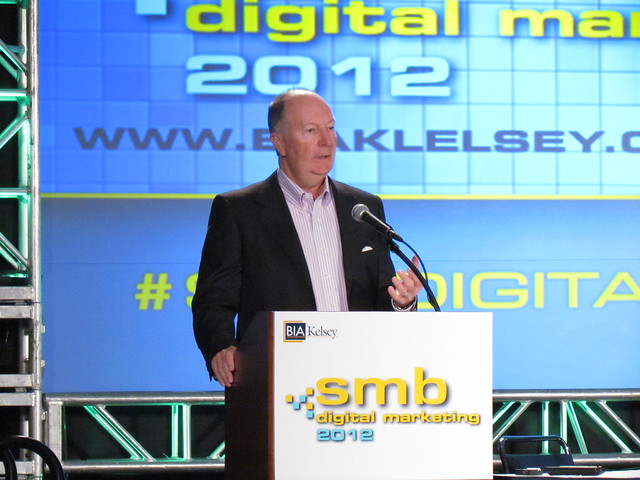
Kicking off Day 2 of our SMB Digital Marketing Conference, DexOne’s EVP of Sales & Marketing Richard Hanna offered insights into the changing realities of selling advertising to SMBs. This is particularly timely in the immediate wake of his company’s merger with Supermedia, further signaling the changing nature of the local media industry.
Part of that change is being accelerated by online, mobile, social and the broadening set of options flying at SMBs. The expectations, and evolving technological savvy of SMBs, are all factors that compel a transformation in how media sales work at the local level. In short, lots of flexibility and technological sophistication need to be infused.
“Print was still a growth industry in 2007,” said Hanna. “That was just 5 years ago, which shows how fast things change with digital transformation. If you believe you’ve caught up, you’re still in denial. It’s constantly changing.”
Part of this is broadening the level of offerings, in keeping with our LCM data presented yesterday that shows the average number of ad media per advertiser steadily rising. Additionally, Hanna presented findings of a Dow Jones survey showing that marketing will be the top budgeted area for SMBs in 2 years, beating out CRM and productivity tech.
The challenge is that over the past 5 years the SMB “share of wallet” has moved from print to digital but print publishers largely haven’t innovated digital products to get those dollars. This goes back to the classic innovator’s dillema, and the canibalization challenge in actively offering products that “trade analog dollars for digital pennies”.
So it’s easier said than done, but a vital move. And the way to justify it is to increase average revenue per advertiser (ARPA) by engineering product bundles. These can not only effectively promote each other (as mentioned yesterday) but also lead to more entrenched relationships with each advertiser. That translates to retention.
Quantifying that, Hanna asserts that 60 percent of DexOne revenues are now from product bundles, leading to 10-20 percent increases in billings per advertiser. This has come about due to these bundles’ ability to sell back into an advertiser with additional products that enhance the overall mix (i.e., mobile, social, etc.).
So how did it go about doing this? One was lots of investment in digital products such as its search product DexNet, DexOne IYP, and best of breed partners like Google for search and PaperG for display advertising. It’s also starting to offer mobile optimized websites, as many other publishers are.
But harder than the product engineering was the realities of selling it… and of training an entrenched sales force to push a broader and different product set. This aligns with the industry-wide move towards an agency-like service model for SMBs. This challenge is underscored by the fact that its sales force collectively calls on 5000 SMBs per day.
On the list of things to do to transform the sales force is lots of training — in DexOne’s case a revamped compensation structure and a formalized certification process for digital sales. It also did things like adding 1000 reps in the last 2 years and arming each one with an iPad — a boon for sales automation according to Hanna.
“You have to do these things to transform them to a digital world,” he said.


This Post Has 0 Comments